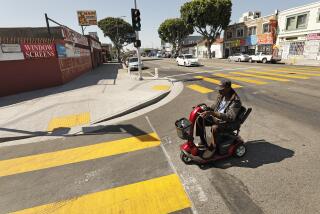Inside Out
- Share via
SHERMAN OAKS — At the Forever Young used clothing shop on Ventura Boulevard, the clothes rack on the sidewalk is definitely out. But the potted plants framing the store’s doors? Probably in.
But this isn’t about fads. This is about rules, and according to the city, displaying merchandise in front of one’s shop is against the law--and has been for about 40 years.
After a minor dust-up with merchants, however, city officials are now fine-tuning the ordinance that regulates sidewalk displays, trying to make it easier for shopkeepers to put out decorative touches like flower baskets while still outlawing goods and signs. So Eugene Winnik’s plants outside Forever Young will likely be able to stay in the sun--but the secondhand clothes will have to be pulled inside, a move he says will hurt business.
“It’s like another advertisement. People see the rack; they stop,” Winnik said, adding: “It’s against our windows. It’s not sitting in the middle of the sidewalk.”
But impeding pedestrians isn’t the only consideration, opponents of sidewalk displays say. There is the matter of reputation and looks, which they feel suffer from the displays.
“This is not some cheap neighborhood. It’s not a swap meet on the boulevard,” said Richard Close, president of the Sherman Oaks Homeowners Assn. “This is not the type of atmosphere [we want] on our main street.”
Tension over the ordinance flared briefly before the holidays, when a city inspector went door to door down Ventura Boulevard in Sherman Oaks and Studio City, issuing written warnings to about 150 shopkeepers who had anything in front of their stores, whether flowers or furniture.
The merchants took exception.
“We started to get a lot of calls, specifically the issue of planters and such,” said Sharon Mayer, City Councilman Mike Feuer’s chief field deputy in the San Fernando Valley.
“It didn’t make sense,” continued Mayer. “On the one hand we’re trying to encourage beautification of the boulevard, but then to penalize somebody for having a plant at their front door didn’t seem reasonable.”
With Feuer’s encouragement, the city’s Public Works Department has begun working on modifications to the law, which would still require merchants to obtain permits for any decorative sidewalk displays but make it faster and cheaper. Shopkeepers would be able to send in photos showing what they wish to set out on the sidewalk to prettify the area, which inspectors could approve on a case-by-case basis for a nominal fee.
“There are some basic rules in the city which are unduly broad,” Feuer said. “The rules need to be flexible, and we need them to be situation-specific.”
In contrast to L.A.’s strict policy against allowing merchandise to spill out onto the sidewalk, other municipalities have moved to liberalize their sidewalk display statutes.
Last year, as part of a revitalization campaign, Culver City council members approved the display of certain kinds of merchandise, including antiques, books and artwork, in the downtown district. The measure has proven so popular that officials are now considering expanding it to cover the entire city.
Ironically, Culver City is counting on the outdoor displays to attract customers, pump up the local economy and promote pedestrian traffic--exactly the opposite effect some homeowners say is happening along Ventura Boulevard, where the displayed wares have been similarly upscale.
“That’s not a draw. It cheapens the area,” Close said. “The sidewalk is for walking. It’s not for selling merchandise.”
Plants and flowers are fine for aesthetic effect, said Close, who is amenable to Feuer’s efforts.
The no-merchandise restriction still chafes merchants who say they depend on such tactics to hook customers, especially when they have to compete against malls.
Circa Circa, which has sold collectibles and vintage clothing in Studio City for just 14 months, relies on the antiques and the clothes rack on the sidewalk to draw in shoppers who might otherwise walk or drive past.
“You should see the difference it makes in my business,” said owner Barbara Cohen, who initially withdrew her outdoor displays after being cited by the city but has since put them back outside.
She may be tempting fate, but said, “I’m waiting for them to come and harass me.”
One alternative now under discussion, which might help ease the plight of shopkeepers like Cohen, is to designate special zones where certain types of merchandise could go on display, such as collectibles in the antique district along La Brea Avenue.
But that option is still in its conceptual stages as officials hammer out such issues as liability.
More to Read
Sign up for Essential California
The most important California stories and recommendations in your inbox every morning.
You may occasionally receive promotional content from the Los Angeles Times.











